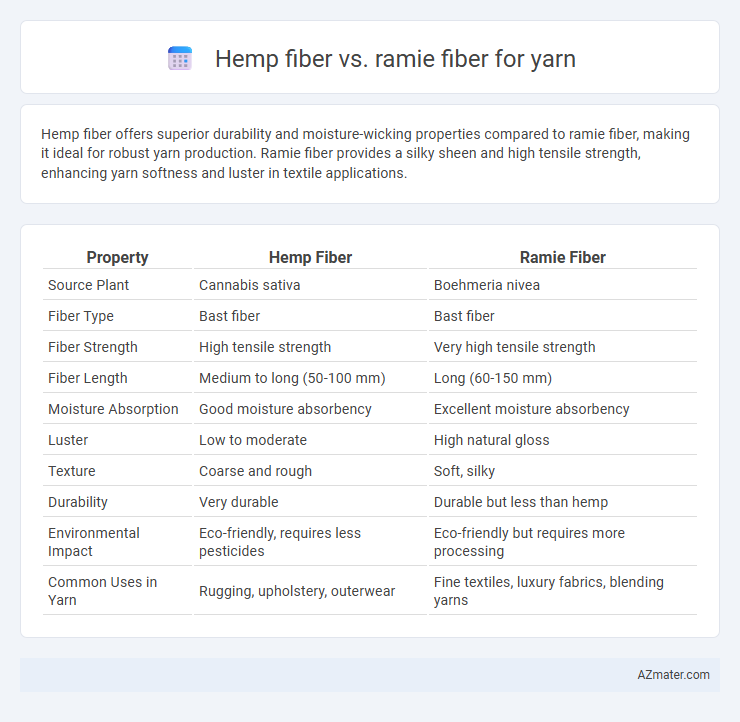Hemp fiber offers superior durability and moisture-wicking properties compared to ramie fiber, making it ideal for robust yarn production. Ramie fiber provides a silky sheen and high tensile strength, enhancing yarn softness and luster in textile applications.
Table of Comparison
| Property | Hemp Fiber | Ramie Fiber |
|---|---|---|
| Source Plant | Cannabis sativa | Boehmeria nivea |
| Fiber Type | Bast fiber | Bast fiber |
| Fiber Strength | High tensile strength | Very high tensile strength |
| Fiber Length | Medium to long (50-100 mm) | Long (60-150 mm) |
| Moisture Absorption | Good moisture absorbency | Excellent moisture absorbency |
| Luster | Low to moderate | High natural gloss |
| Texture | Coarse and rough | Soft, silky |
| Durability | Very durable | Durable but less than hemp |
| Environmental Impact | Eco-friendly, requires less pesticides | Eco-friendly but requires more processing |
| Common Uses in Yarn | Rugging, upholstery, outerwear | Fine textiles, luxury fabrics, blending yarns |
Introduction to Hemp and Ramie Fibers
Hemp fiber, derived from the stalks of the Cannabis sativa plant, is known for its durability, natural resistance to pests, and eco-friendly cultivation requiring minimal water and pesticides. Ramie fiber, extracted from the stalks of the Boehmeria nivea plant, offers exceptional strength, lustrous appearance, and high absorbency, making it ideal for blending in fine yarns. Both fibers are biodegradable and increasingly popular in sustainable textile production, with hemp providing coarse yarn qualities and ramie contributing softness and sheen.
Botanical Origins and Plant Characteristics
Hemp fiber is derived from the stalk of the Cannabis sativa plant, known for its tall, fast-growing stems and strong bast fibers ideal for durable yarn production. Ramie fiber comes from the stalks of the Boehmeria nivea plant, a flowering perennial native to eastern Asia, valued for its lustrous, silky texture and resistance to bacteria and mildew. Both fibers offer natural strength and sustainability but differ botanically, with hemp belonging to the Cannabaceae family and ramie to the Urticaceae family.
Fiber Extraction Processes
Hemp fiber extraction involves retting methods such as water retting, dew retting, and enzymatic retting to separate fibers from the stalk, ensuring strong, durable fibers for yarn production. Ramie fiber extraction primarily uses decortication, where the bark is stripped mechanically or chemically treated to remove non-fibrous materials, yielding lustrous and fine fibers ideal for blending in yarn. Both processes impact fiber quality, with hemp's retting affecting toughness and ramie's decortication influencing sheen and smoothness in the final yarn product.
Physical Properties Comparison
Hemp fiber exhibits high tensile strength, durability, and resistance to UV light, making it ideal for producing strong and long-lasting yarns. Ramie fiber is characterized by its exceptional luster, smooth texture, and good moisture absorption, enhancing yarn softness and comfort. Both fibers possess excellent biodegradability, but hemp typically offers greater abrasion resistance, while ramie provides better dye affinity and brightness in yarn applications.
Strength and Durability
Hemp fiber exhibits superior tensile strength compared to ramie fiber, making it an ideal choice for durable yarn production. The natural lignin content in hemp enhances its resistance to wear and environmental stress, contributing to longer-lasting textiles. Ramie fiber offers moderate strength but excels in luster and softness, which may compromise durability under heavy usage.
Moisture Absorption and Breathability
Hemp fiber exhibits superior moisture absorption, with a capacity to retain up to 12-15% of its weight in water, enhancing comfort in yarn applications by wicking away sweat effectively. Ramie fiber, while also breathable, has a lower moisture regain of approximately 8-9%, which results in less effective moisture management compared to hemp. Consequently, hemp yarns are preferred for garments requiring high breathability and moisture control due to their natural hydrophilic properties and durable fiber structure.
Environmental Impact and Sustainability
Hemp fiber and ramie fiber both offer sustainable alternatives in yarn production, with hemp requiring significantly less water and pesticides compared to conventional cotton, making it highly eco-friendly. Ramie fiber, known for its natural resistance to pests, also demands minimal chemical treatments and has excellent biodegradability, contributing to lower environmental impact. The renewable nature and rapid growth cycles of both fibers position them as sustainable choices in the textile industry, supporting reduced carbon footprints and promoting soil health.
Dyeing and Color Retention
Hemp fiber exhibits excellent dye absorption due to its porous structure, resulting in vibrant colors and strong colorfastness in yarns. Ramie fiber, known for its smooth surface and natural luster, allows dyes to adhere well but may require mordants to enhance color retention and prevent fading. Both fibers support a range of dye types, though hemp's higher chemical affinity generally yields deeper, longer-lasting shades in textile applications.
Applications in Yarn and Textiles
Hemp fiber offers durability, moisture-wicking, and antimicrobial properties, making it ideal for robust, eco-friendly yarns used in apparel, upholstery, and industrial fabrics. Ramie fiber provides a silky luster, high tensile strength, and excellent breathability, favored in lightweight, breathable textiles such as summer clothing, home furnishings, and blends with cotton or wool for enhanced texture. Both fibers excel in sustainable textile production, with hemp suited for heavy-duty textiles and ramie ideal for fine, lustrous yarn applications.
Conclusion: Choosing Between Hemp and Ramie for Yarn
Hemp fiber offers exceptional strength, durability, and natural resistance to pests and mold, making it ideal for rugged, eco-friendly yarn applications. Ramie fiber provides a silky texture, high absorbency, and ease of dyeing, suitable for lightweight and luxurious yarn products. Selecting between hemp and ramie depends on the desired fabric qualities: hemp excels in toughness and sustainability, while ramie is preferred for softness and luster in yarn production.

Infographic: Hemp fiber vs Ramie fiber for Yarn
 azmater.com
azmater.com